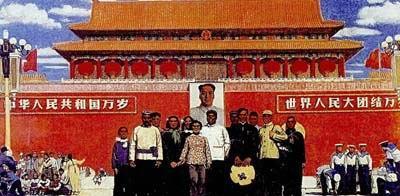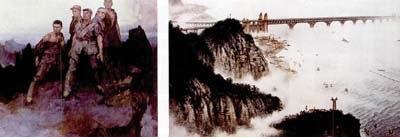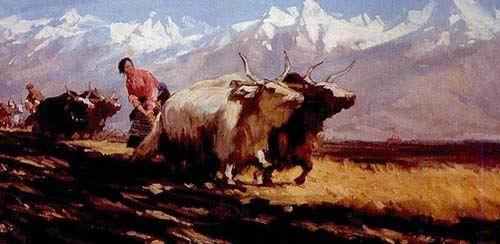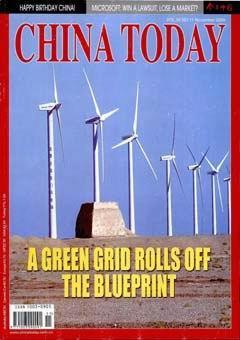New China’s Fine Art Revolution
By staff reporter WU BING



WHEN centuries of artistic development were transplanted into a revolutionary culture reinventing its traditions, what unfolded was a half century of the most interesting developments in Chinas art scene.
One day in early September this year the National Art Museum of China was packed with people clambering to take in Fine Arts Through the 60 Years of New China, for the 60th anniversary of the Peoples Republic. In front of Wang Wenbins oil Tamping Song, I heard a Western viewer ask the lady beside her, “What are the girls doing in the picture?” “They are ramming,” answered the woman, adding, “Villagers used blocks of stone like that on harnesses made of rope to ram pack the earth for building houses, threshing grounds and roads. They sang a song to coordinate their movements of lifting and dropping the stone.” “Incredible. How could they all look so happy and poised as if they were dancing while doing such heavy labor?” murmured the Western guy, sounding unconvinced.
The oil, in fact, bears a distinct stamp of its time, typical of the early period of New China when gender equality was promoted and women encouraged to throw themselves into socialist construction alongside their male comrades. Robust “iron girls” were widely cited as role models for the so-called gentler sex, and women of grace and beauty vanished from art works. Meanwhile, a tone of enthusiasm and jubilance in quotidian toil became the stereotype for revolutionary romanticism in art. The collected masterpieces from six decades on show at the museum are drawn from various art forms, creating a stepping-stone path of the “revolution” in fine art in the Peoples Republic of China.
Out with the Old
The revolution in New Years prints was one prelude to the shake-up in artforms that marked the dawn of New China. It had been a centuries-old practice for the Chinese to post woodblock prints on their doors and walls before each Spring Festival, popularly known as New Years prints. Instead of the traditional tableaus of “Door Gods” and “God of the Kitchen,” millions of newly emancipated working people celebrated their first Spring Festival in New China by putting up prints with new, revolutionary themes. Beaming farmers with their harvest of big melons and other fruits, and state leaders visiting villagers, better expressed peoples joy over their improved living standards and heightened social status.
Another change in the New Years prints of the time was admission of genres other than the traditional waterprint woodcut. They were expanded to include aquarelle and ink and wash painting, including the gongbi style, or the detailed and fine brushwork approach of traditional Chinese painting. Apart from the stand-by pigments typically used, watercolors and gouache were also put to extensive use, making the folk genre more textured and animated. This new style of New Years print has remained popular across China, particularly among villagers. Peoples Heroes and Spring of China are two masterpieces of the category. The former was created by Wang Baishun (1939-) in 1984, portraying the ten founding marshals of the Peoples Republic of China. The latter was a co-production of Chen Jiwu (1942-), Mao Guofu (1937- ) and He Yeqi (1950-) depicting Deng Xiaopings historic visit to Shenzhen that set the course of Chinas reform and opening-up.
The Ascendance of Oil
Oil has always been a favored medium in the history of fine arts in New China, and oil paintings served as tools of propaganda, particularly during the period when photography and printing were not advanced enough to produce forms of expression quite as dramatic. The decade of the 1950s saw many artists devoting themselves to creating oils featuring historic themes. Unlocking the Shackle by Hu Yichuan, The Tunnel War by Luo Gongliu and Capturing the Lu-ding Bridge by Li Zongjin exhorted the general public to learn from the example of revolutionary heroes and throw themselves heart and soul into the construction of a socialist China. Dong Xiwens (1914-1973) Founding Ceremony of the Peoples Republic of China might be the most famous oil of the decade. He represented a solemn and proud moment in New China and rendered it in a classic foreign medium.
Oil brush techniques and the artistic languages of the decade were mainly influenced by Russian artists. Between 1955 and 1957, an oil painter from the former Soviet Union, Constantine M. Makchmov, taught a course in advanced oils at the Central Academy of Fine Arts by invitation of the Chinese government. Makchmovs students filled the ranks of that first generation of Chinese oil painters, including Jin Shangyi (1934-), Zhan Jianjun (1931-), He Kongde (1925-), Wang Wenbin (1932-) and Sun Zixi (1929-). They created, respectively, Full-length Portrait of Chairman Mao, The Five Heroes on Langya Mountain, Before the Attack, Tamping Song and Having a Photo Taken in Front of the Tiananmen Rostrum. Embodying the spirit of revolution, these works are all based on real people, events and preoccupations of the time. They are celebrated as ground-breaking masterpieces in New Chinas fine art legacy.
In the early 1980s, the countrys reform and opening-up introduced new perspectives, approaches and genres from the Western art world that quickened the hearts and minds of young artists. Photorealism, a style with fidelity to detail so fine the effect is photographic, emerged in the United States in the early 1960s and transfixed Luo Zhongli (1948-) and Guang Tingbo (1938-). The painters adopted it successfully in the epoch-making oils Father, by the former, and Drops of Melted Steel and Sweat by the latter.
Traditional Painting Revisited
By this time, traditional Chinese painting was branded as a repository of ideas and sentiments belonging to the feudal literati. Considered unsuitable for the expression of revolutionary scenes and the spirits of workers, farmers and soldiers, it was eclipsed by New Years prints and oils in the early years of the Peoples Republic.
Some set about, however, to transform this artistic heritage to suit the needs of a new period and soon made a breakthrough with one of the three traditional categories – figure painting. Revolution-era figure painting applied the tradition to the motif of happy industriousness, and was pioneered by Yang Zhiguang (1930-). His masterpieces included The First Time in My Life and Sending Food on a Snowy Day. Fang Zengxians (1931-) iconic work portrayed an old farmer picking wheat heads fallen from a cart in his Every Grain Is the Fruit of Hard Labor.
In the 1950s and 1960s, landscape and bird-and-flower paintings – the other two categories in the heritage – were also generally considered “incapable of reflecting real life and unsuitable for large compositions.” In practice this was proved untrue by masters of the genre such as Pan Tianshou (1897-1971), Guo Weiqu (1908-1972) and Li Keran (1907-1989). Pan Tianshou went to the Yandang Mountains several times to do sketches and completed a number of large bird-and-flower works that measured 145 cm x 360 cm. Guo Weiqu produced many works of the genre that were themed on farming tools, agricultural produce, and generally euphemistic exaltation of the arduous rural life.
Meanwhile, landscape artists went to construction sites in mountainous areas to see life there for themselves. Working side-by-side with local farmers, miners and road builders, they created a special body of work in revolutionary landscapes set off by bridges that span mountains, trains that pass through tunnels, or building sites buzzing with construction workers. Traditionally, compositional elements such as temples, monks, scholars or animals were added as touches to landscapes. Newly-dressed Mountains and Rivers by Lu Yanshao (1909-1993) audaciously features a reservoir dam and power grid in the foreground. Road Across the Heavenly Moat by Wei Zixi (1915-2002) focuses on the Nanjing Yangtze River Bridge. These “landscapes” are also defined by their time.
Beginning in the 1980s, traditional Chinese painting experienced an unprecedented period of diversity and exuberance, though the exaltation of Chinese culture and national spirit remained mainstream in these works. Li Shaowen (1942-) broke the old rule of “content determines form” in his Nine Songs – a series of human figures exaggerated and reshaped to the demands of the composition and done in fine brushstrokes and saturated colors. Young artist He Jiayings (1957-) elegant and soothing Sour Grape and Autumn Meditation are atmospheric and near-perfect depictions of young women.
Acclaimed artist Wu Guanzhong (1919-) fused Chinese and Western styles, declaring that he would “pull down the wall around the Chinese painting.” He subjected his choice of materials and techniques to an aesthetic primacy, intending the forms of his “modern landscapes” to “appeal to the eye.” He arranged color blocks of various sizes and shapes into sequences that generated visual pleasure and excitement. Masterfully transforming the white-walled and black-tile-roofed residences of southern riverside towns into separately perceived graphic elements, he then reassembled them into a dazzling array of houses warped and woofed by rivers and bridges.
The revolution influenced by the West was also recognized by the West. In 1992, the British Museum mounted a solo show for Wu Guanzhong, the first living Chinese artist ever exhibited by the museum.
The Practical and the Populist
The founding of the Peoples Republic triggered a massive investment in public statuary by cities busy erecting monuments and commemorative sculptures. Public art provided great opportunities for sculptors working in bronze and stone.
The serial relief that surrounds the foundation of the Monument to the Peoples Heroes on Tiananmen Square was a trend-setting masterpiece of New China. A group of sculptors led by Liu Kaiqu (1904-1993) represented the history of the Chinese revolution through slabs of relief work commemorating such major events as Lin Zexu burning opium at Humen, the Jintian and Wuchang Uprisings, and the May Fourth Movement. The three works by Wang Chaowen (1909-2004) – The Relief of Mao Zedong, Militia and Liu Hulan, along with Hard Days by Pan He (1925-) are also considered icons of revolutionary romanticism.
With reform and opening-up, sculpture in China diversified, moved on from collectivist glory, and caught up to the 21st century values of personal expression and individual style. The new works voiced concern about social issues and the human condition, highlighted contemporary sculptural forms and languages, and pursued an artistic agenda designed to raise the sophistication and international status of Chinese sculpture.
Black-white woodcuts are a more economical art form, being small and made of common material. Print-making thrived during the Yanan period (1935-1948) as a mainstream art form and continued to dominate until the late 1950s. In the 1960s, print master Chao Mei (1931-) led a group of young artists in borrowing from styles of composition and technique endemic to the former Soviet Union and introducing color into a formerly black-white art form. The result was “prints of the Northern Wilderness,” so nicknamed for showing natures splashy changes of seasons, and farmlands against a background of mountains and rivers.
Another European staple – stone and copper lithographic prints – came to the Peoples Republic as a “new” art form. In the 1950s the Chinese government sent a group of young print artists, including Quan Xianguang (1931-) and Fu Chuanxi (1932-), to Leipzig, Germany, to study. Six years later they brought back stone and copper lithography, and German drawing techniques that opened the eyes of Chinese artists to an artistic approach differing from that of the former Soviet Union. Lithographic art has since flourished in China, producing a large number of epical works.
In the 1960s and 1970s, the poster was king of pop art, as in the West, but cartoons and flip-books (cartoons with one frame per page) also developed quickly. Many masterpieces of cartooning appeared during the two decades. Hua Junwu (1915-) was an outstanding satirist of that genre widely known for his visual commentary on social ills.Scientific Division of Labor was one, famous for criticizing redundant government organizations. Flip books such as The Romance of Three Kingdoms, Lenin in 1918 and Cock-feathered Letter were also widely popular illustrated works.
Gouache, watercolor and lacquer arts have also produced many lovely works of art over the past six decades though they assume lower status in Chinese art circles. Gouache and watercolor, in particular, have gone from being auxiliary materials for art student projects, to an independent art form; in fact they have dominated many art exhibitions over the past two decades.
Storm Before the Calm
At the 89 Modern Arts Exhibition at the National Art Museum of China in February 1989, a long-haired girl astonished the crowd by pointing a gun at her installation work, Dialogue, and firing two shots. Creative energy in New China had reached explosive levels. At the same exhibit, an artist washed his feet in a basin lined with portraits of Ronald Reagan. Before it closed, another walked the three floors of the venue, casting condoms in front of almost every display. Still another artist kept vigil over 18 eggs on the second floor, in a hat and paper body tent on which was written: “Hatching time and no argument, for the sake of the next generation.” Time Magazine carried a story on the events entitled “Eggs, Gunshots and Condoms.”
The exhibition was considered the natural outcome of the ‘85 New Wave Movement. By the 1980s, the artistic vanguard had grown dissatisfied with the monotony of painting on canvas. At first they experimented with abstracts by assembling geometric forms and symbols with cultural significance. Later they texturized their oils by gluing bottles, matchboxes and other daily detritus to the surfaces for enhanced power of expression. Finally, Western installation art came to the fore in which young artists used everyday objects in this avant-garde modern art form to express their ideas, bringing this genre to its zenith around 1985.
The derivative works of the New Wave form a record of a dreaming and sleepwalking phase in contemporary Chinese art history. After the 89 exhibition, artists moved on to find their own unique inspiration, forms and languages. From unsophisticated representations of lives as they are, to subjective interpretations in unconventional languages, modern art in China has evolved at an astonishing speed.
Over the last two decades, Chinese artists have nurtured a mature and rational sensibility, and entered a new realm of depth and stability. We expect the best is yet to come.

